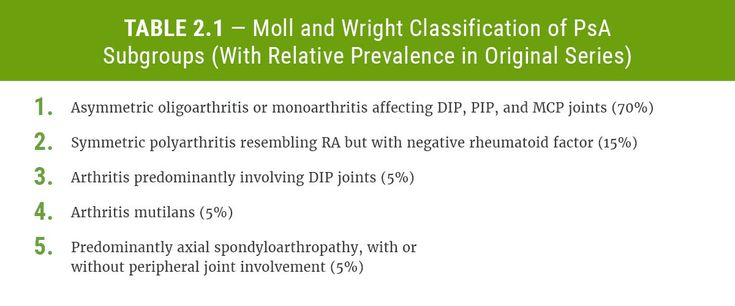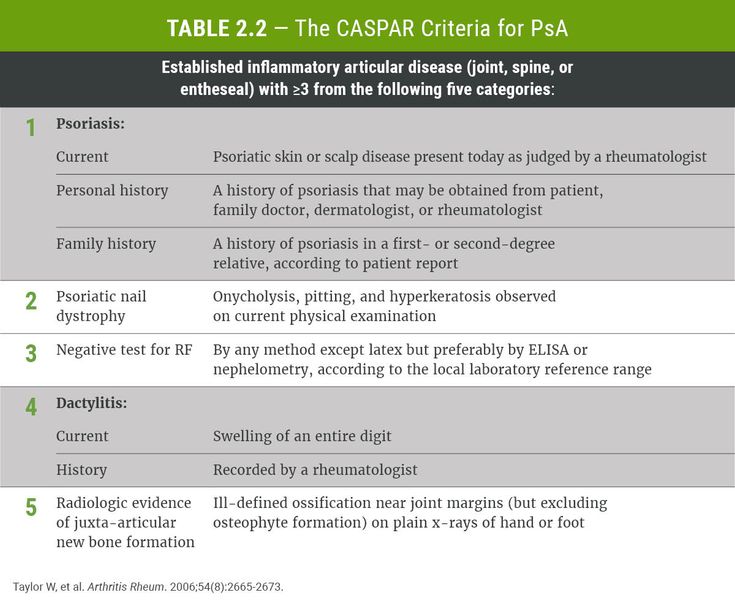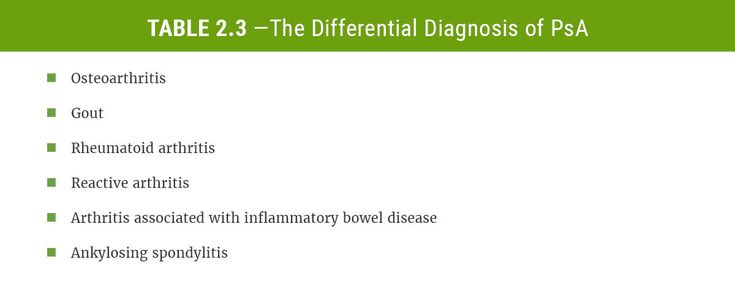Epidemiology and Classification of Psoriatic Arthritis
Classification of PsA
Historically, psoriatic arthritis was presumed to be simply a variation of rheumatoid arthritis in patients who also happened to have psoriasis. Verna Wright, a professor in Leeds, UK, first proposed classifying psoriatic arthritis (PsA) as a distinct clinical entity in the 1950s, and her delineation of the clinical patterns of joint involvement this disease, first published with John Moll in 1973, remains in widespread use today. With this publication, Moll and Wright divided PsA patients into five distinct patterns of peripheral and axial arthritis (Table 2-1).
While still widely applied (and frequently reported in clinical trials of new therapeutics), the Moll and Wright scheme for separating PsA patients by pattern of joint involvement has its limitations. Joint involvement may change over time, so that patients originally classified under one pattern of involvement may develop into another. Within this classification scheme, isolated distal interphalangeal (…
To continue reading
Log in or register to continue reading. It's free!
OR
By signing up to create an account, I accept Healio's Terms of Use and Privacy Policy.
Classification of PsA
Historically, psoriatic arthritis was presumed to be simply a variation of rheumatoid arthritis in patients who also happened to have psoriasis. Verna Wright, a professor in Leeds, UK, first proposed classifying psoriatic arthritis (PsA) as a distinct clinical entity in the 1950s, and her delineation of the clinical patterns of joint involvement this disease, first published with John Moll in 1973, remains in widespread use today. With this publication, Moll and Wright divided PsA patients into five distinct patterns of peripheral and axial arthritis (Table 2-1).
While still widely applied (and frequently reported in clinical trials of new therapeutics), the Moll and Wright scheme for separating PsA patients by pattern of joint involvement has its limitations. Joint involvement may change over time, so that patients originally classified under one pattern of involvement may develop into another. Within this classification scheme, isolated distal interphalangeal (DIP) joint involvement and arthritis mutilans, while both unusual, are the most specific joint findings indicating PsA. Interestingly, response to therapy has not been shown to differ between subtypes, except for axial disease, which is less responsive to some treatments.
CASPAR Criteria
As newer therapies for psoriatic arthritis become available, accurate classification of this disease itself has become increasingly important. Over time, other authors have proposed newer classification schema, but none of these generated widespread use until, in 2008, CASPAR, a cooperative international effort, reviewed the existing classification schemes and developed new criteria for PsA. The CASPAR group took elements of existing, published criteria and applied them to representative cases of PsA to develop a criteria set that had the highest levels of sensitivity and specificity for PsA. The CASPAR criteria (Table 2-2), when applied to patients with inflammatory joint, axial or entheseal disease, identify patients with PsA with high specificity.
When considering the CASPAR criteria, it is important to remember that they presuppose that the patient has presented with inflammatory musculoskeletal manifestations; without these, the other elements of history and exam should not be considered, and the disease cannot be classified as PsA. It should also be noted that current or past presence of psoriasis is a key element of these criteria; current psoriasis is weighted twice as much as any other component. On the other hand, a diagnosis of PsA can be made with the CASPAR criteria even without a diagnosis of psoriasis, especially when there is a family history of psoriasis or nail changes in the individual being considered.
Features of PsA
Psoriatic arthritis falls into the broad category of spondyloarthropathies. These conditions, which share a number of clinical features, include ankylosing spondylitis, reactive arthritis, the arthritis associated with inflammatory bowel disease (IBD), and more rare conditions including Whipple’s disease and SAPHO (synovitis, acne, pustulosis, hyperostosis and osteitis) syndrome, in addition to psoriatic arthritis (PsA). While the root of the term, spondy, refers to the spine, patients with spondyloarthropathies frequently have enthesitis and dactylitis, as well as axial involvement. The joint involvement in these conditions is often asymmetric and oligoarticular, with a predilection for lower extremity involvement. Inflammatory eye involvement, typically in the form of uveitis, is also common. In contrast to rheumatoid arthritis (RA), spondyloarthropathies do not preferentially affect women; PsA itself is equally distributed among men and women.
The synovitis in PsA is similar to the joint involvement in other types of inflammatory arthritis, with swelling, tenderness, erythema and stiffness in the involved joints; some authors have suggested that involved joints in PsA tend to be less tender than those in RA. Both small and large joints may be involved in PsA. Dactylitis and enthesitis are unique clinical findings that may be seen in this disease. Dactylitis, also referred to as sausage digits, may involve either fingers or toes, and reflects inflammation both in the joints of the digits and along tendon sheaths. Often considered a hallmark of PsA, it may also be seen in other spondyloarthropathies. Enthesitis, or inflammation at the entheses, the point at which tendons attach to bone, is another feature of spondyloarthropathies that is frequently seen in PsA. Although isolated axial involvement is uncommon in PsA, lumbar spine and sacroiliac arthritis may accompany peripheral joint disease.
Nail changes, ranging from pitting, to oil spots, to frank onycholysis are a common finding in psoriasis and appear to be particularly associated with PsA. The overall prevalence of nail involvement in psoriasis is approximately 40%, while more than 80% of PsA patients will have nail findings. Nail abnormalities are often seen in association with arthritis in the distal interphalangeal (DIP) joint of the same digit, and recent studies have suggested that these abnormalities may arise from inflammation in the DIP joint, which may help to explain the correlation between nail changes and PsA (Figures 2-2, 2-3 and 2-4). The presence of nail abnormalities in a patient with psoriasis and musculoskeletal symptoms should always prompt consideration of PsA.
Just as nail changes are associated with the presence of PsA, there is some evidence that the severity of skin disease plays a role. As identified in the CASPAR criteria, active skin involvement is not a necessary prerequisite to the diagnosis of PsA. Moreover, the severity of the skin disease does not correlate with the severity of the joint disease, nor does control of skin disease reduce the activity of the joint disease. There is evidence, however, that the extent of skin involvement may be associated with the likelihood of developing PsA.



Differential Diagnosis of PsA
The differential diagnosis of psoriatic arthritis (PsA) can be quite broad and includes both inflammatory and non-inflammatory types of arthritis (Table 2-3). Osteoarthritis (OA) should always be a consideration, especially in the setting of hand and spine involvement, although OA would be an unusual finding in younger patients. OA in the hands preferentially involves the DIP joints, and there may be erythema of these joints suggestive of an inflammatory process, but the radiographic findings should be distinguishable from those of PsA. Clinically, nail changes, particularly in those digits with distal interphalangeal (DIP) arthritis, may help to identify the diagnosis as PsA rather than OA.
Degenerative arthritis of the spine may cause axial symptoms in patients with concurrent psoriasis. Prolonged morning stiffness, either in peripheral joints or the spine, is not a typical feature of degenerative arthritis and, when present, should prompt consideration of an inflammatory arthritis such as PsA. Radiographic changes in the spine resulting from degenerative disc disease should also be distinguishable on X-ray from the syndesmophytes and sacroiliitis that can accompany PsA. Radiographically, diffuse idiopathic skeletal hyperostosis (DISH), in which there is calcification of the anterior longitudinal ligaments of the spine, may suggest the syndesmophyte formation that can be seen in PsA, but careful evaluation should be able to distinguish the two.
Differentiating rheumatoid arthritis (RA) from PsA may prove more challenging, especially in those psoriatic patients with rheumatoid-like polyarticular involvement. Asymmetrical joint involvement would argue for PsA over RA, as would DIP joint involvement, as these joints are rarely affected in RA. Tendonitis can occur in RA, but prominent symptoms of enthesitis, particularly when joint involvement itself is relatively mild, should prompt consideration of PsA or another spondyloarthropathy. The inflammatory low back pain that can accompany PsA can also help distinguish it from RA; cervical spine involvement may be seen in RA, but lumbar spine involvement is rare.
Finally, PsA needs to be distinguished from other forms of spondyloarthropathy. A history of inflammatory bowel disease (IBD) would suggest a diagnosis of IBD-associated arthropathy, and a recent history of gastrointestinal or genitourinary infection should prompt consideration of reactive arthritis. Ankylosing spondylitis (AS) presents with inflammatory low back pain similar to that sometimes seen in PsA, and may also be associated with peripheral arthritis and enthesitis. Radiographic evidence of vertebral ankylosis and bilateral sacroiliitis, as opposed to the unilateral involvement more typically seen in PsA, might suggest this diagnosis of AS.
The clinical manifestations of the spondyloarthropathies may overlap considerably. Recognizing this, the Assessment of Spondyloarthritis International Society (ASAS) has developed new classification criteria for axial and peripheral spondyloarthropathies that are intended to provide a framework for therapy that are based more on symptom complexes than on formal disease definitions. The presence of psoriasis is an important component in both sets of criteria. These criteria remain a work in progress, particularly those for peripheral spondyloarthropathy; some have raised concerns that they threaten to diminish the significance of PsA as a discrete entity by blurring the distinction between this diagnosis and the more general diagnosis of spondyloarthropathy.
Laboratory Findings
On laboratory evaluation, psoriatic arthritis (PsA) patients will not usually have a positive serum test for rheumatoid factor (RF); the CASPAR criteria include a negative RF test. However, this test is nonspecific and may be present, especially at low titers, in patients without rheumatoid arthritis (RA). In particular, a false positive RF is more common in older individuals, so a positive RF test does not necessarily exclude PsA in this group. The finding of antibodies to cyclic citrullinated peptides (CCP) is a more specific serologic test for RA, but these antibodies may be seen in a small percentage of PsA patients as well.
References
- Ruderman EM, Gordon KB. Clinical Management of Psoriatic Arthritis and Psoriasis. 4th ed. Professional Communications Inc. 2022
- Alenius GM, Berglin E, Rantapää Dahlqvist S. Antibodies against cyclic citrullinated peptide (CCP) in psoriatic patients with or without joint inflammation. Ann Rheum Dis. 2006; 65(3):398-400.







